Electric Vehicle: Potential Benefits and Challenges in Australia
VerifiedAdded on 2023/06/05
|12
|3138
|491
AI Summary
This report addresses the potential benefits and challenges of electric vehicles (EVs) in Australia, including issues related to batteries, range, prices, and charging. It also discusses the potential economic and environmental benefits of EVs, as well as the challenges and barriers to their adoption.
Contribute Materials
Your contribution can guide someone’s learning journey. Share your
documents today.
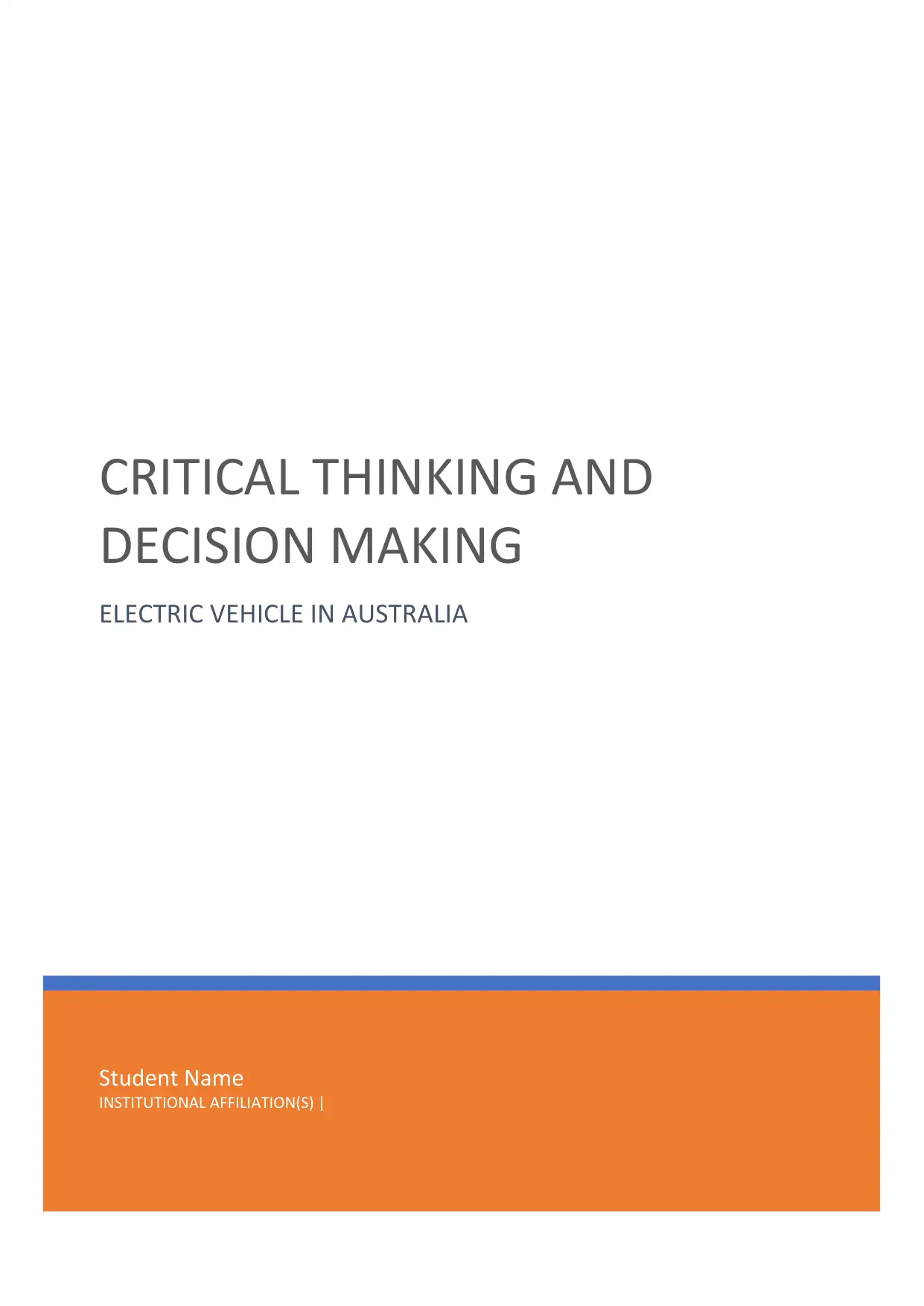
Student Name
INSTITUTIONAL AFFILIATION(S) |
CRITICAL THINKING AND
DECISION MAKING
ELECTRIC VEHICLE IN AUSTRALIA
INSTITUTIONAL AFFILIATION(S) |
CRITICAL THINKING AND
DECISION MAKING
ELECTRIC VEHICLE IN AUSTRALIA
Secure Best Marks with AI Grader
Need help grading? Try our AI Grader for instant feedback on your assignments.

P a g e | 1
Executive Summary
Internationally, there are very few sign-posts that directs towards longer shifts in policies related to
transportation moving away from fossil fuels and stirring towards electricity. The main reason
behind this straightforwardness is due to intensity in CO2 and existing power system that may
represent modest environmental gains due to which customers are preferring switching from
internal combustion engine (ICE) motors to electric vehicles (EV). After finding potential benefits and
challenges of EV, it has been seen that there is a prodigious necessity to look outside traditional
transportation standards and consider issues related in conniving and recharging EVs. This report
has been prepared for managers and organisations of EVs in Australia to address identified
challenges correlated to batteries and range as well as prices and charging issues in electricity driven
vehicles.
Executive Summary
Internationally, there are very few sign-posts that directs towards longer shifts in policies related to
transportation moving away from fossil fuels and stirring towards electricity. The main reason
behind this straightforwardness is due to intensity in CO2 and existing power system that may
represent modest environmental gains due to which customers are preferring switching from
internal combustion engine (ICE) motors to electric vehicles (EV). After finding potential benefits and
challenges of EV, it has been seen that there is a prodigious necessity to look outside traditional
transportation standards and consider issues related in conniving and recharging EVs. This report
has been prepared for managers and organisations of EVs in Australia to address identified
challenges correlated to batteries and range as well as prices and charging issues in electricity driven
vehicles.
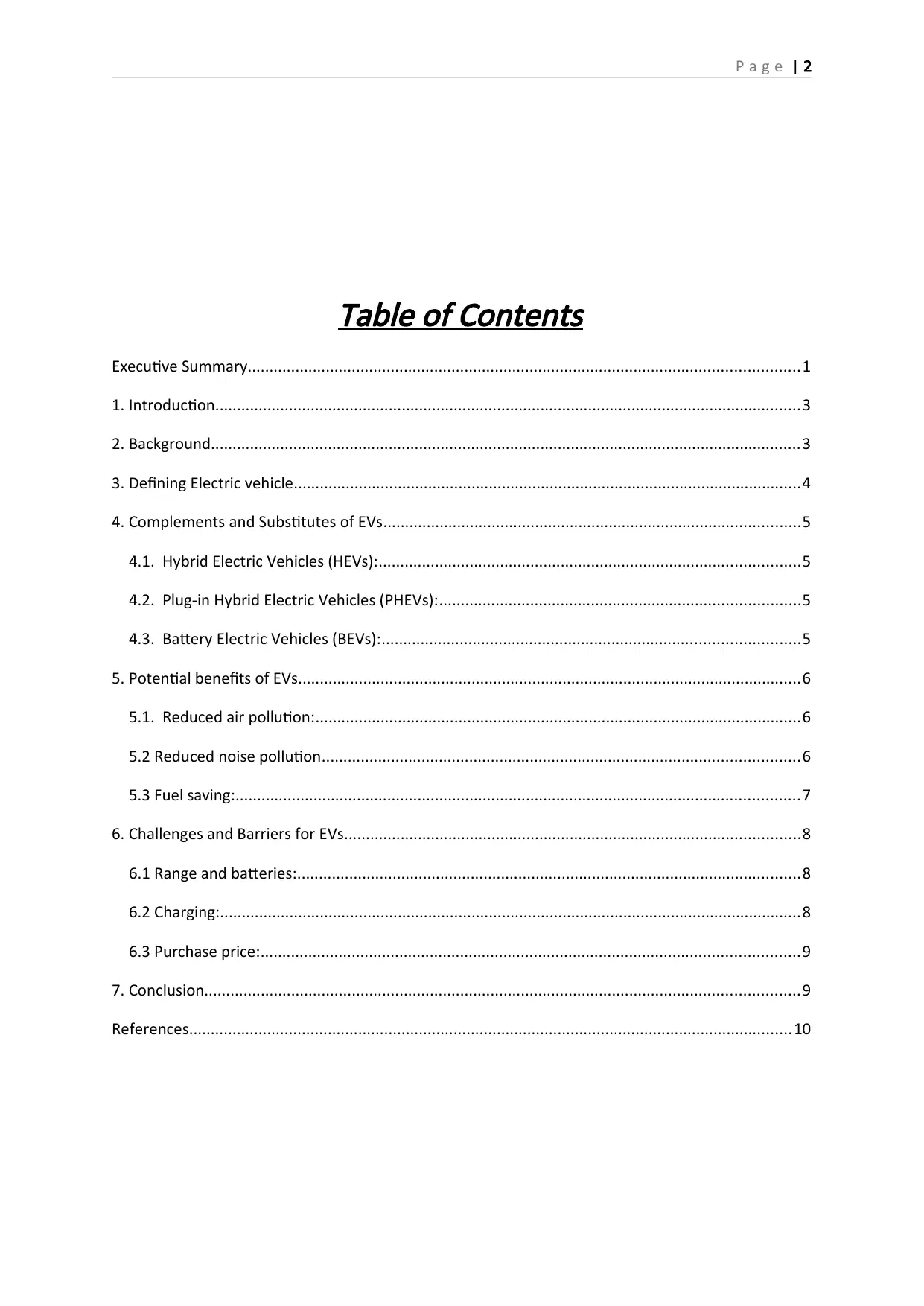
P a g e | 2
Table of Contents
Executive Summary...............................................................................................................................1
1. Introduction.......................................................................................................................................3
2. Background........................................................................................................................................3
3. Defining Electric vehicle.....................................................................................................................4
4. Complements and Substitutes of EVs................................................................................................5
4.1. Hybrid Electric Vehicles (HEVs):.................................................................................................5
4.2. Plug-in Hybrid Electric Vehicles (PHEVs):...................................................................................5
4.3. Battery Electric Vehicles (BEVs):................................................................................................5
5. Potential benefits of EVs....................................................................................................................6
5.1. Reduced air pollution:................................................................................................................6
5.2 Reduced noise pollution..............................................................................................................6
5.3 Fuel saving:..................................................................................................................................7
6. Challenges and Barriers for EVs.........................................................................................................8
6.1 Range and batteries:....................................................................................................................8
6.2 Charging:......................................................................................................................................8
6.3 Purchase price:............................................................................................................................9
7. Conclusion.........................................................................................................................................9
References...........................................................................................................................................10
Table of Contents
Executive Summary...............................................................................................................................1
1. Introduction.......................................................................................................................................3
2. Background........................................................................................................................................3
3. Defining Electric vehicle.....................................................................................................................4
4. Complements and Substitutes of EVs................................................................................................5
4.1. Hybrid Electric Vehicles (HEVs):.................................................................................................5
4.2. Plug-in Hybrid Electric Vehicles (PHEVs):...................................................................................5
4.3. Battery Electric Vehicles (BEVs):................................................................................................5
5. Potential benefits of EVs....................................................................................................................6
5.1. Reduced air pollution:................................................................................................................6
5.2 Reduced noise pollution..............................................................................................................6
5.3 Fuel saving:..................................................................................................................................7
6. Challenges and Barriers for EVs.........................................................................................................8
6.1 Range and batteries:....................................................................................................................8
6.2 Charging:......................................................................................................................................8
6.3 Purchase price:............................................................................................................................9
7. Conclusion.........................................................................................................................................9
References...........................................................................................................................................10
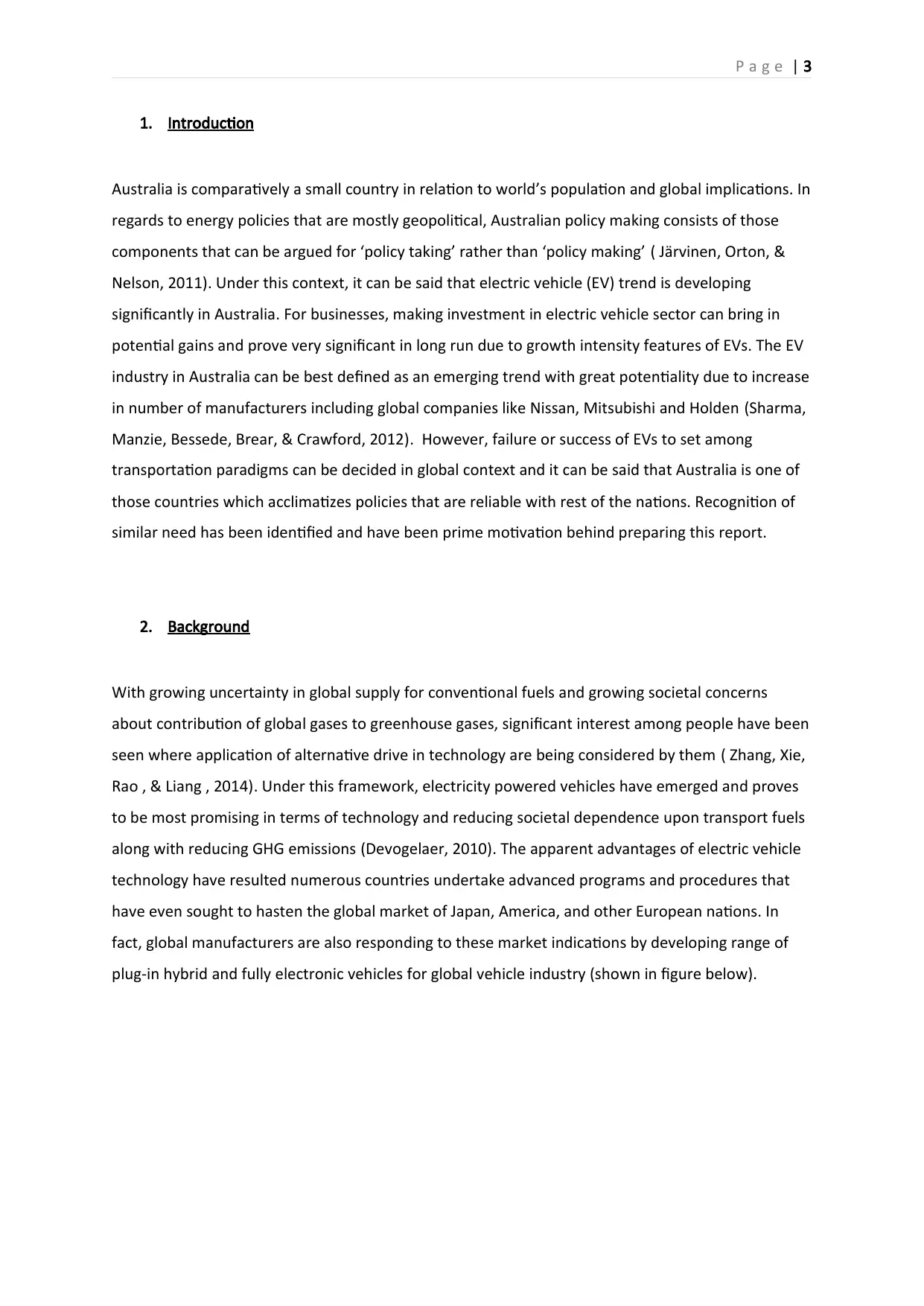
P a g e | 3
1. Introduction
Australia is comparatively a small country in relation to world’s population and global implications. In
regards to energy policies that are mostly geopolitical, Australian policy making consists of those
components that can be argued for ‘policy taking’ rather than ‘policy making’ ( Järvinen, Orton, &
Nelson, 2011). Under this context, it can be said that electric vehicle (EV) trend is developing
significantly in Australia. For businesses, making investment in electric vehicle sector can bring in
potential gains and prove very significant in long run due to growth intensity features of EVs. The EV
industry in Australia can be best defined as an emerging trend with great potentiality due to increase
in number of manufacturers including global companies like Nissan, Mitsubishi and Holden (Sharma,
Manzie, Bessede, Brear, & Crawford, 2012). However, failure or success of EVs to set among
transportation paradigms can be decided in global context and it can be said that Australia is one of
those countries which acclimatizes policies that are reliable with rest of the nations. Recognition of
similar need has been identified and have been prime motivation behind preparing this report.
2. Background
With growing uncertainty in global supply for conventional fuels and growing societal concerns
about contribution of global gases to greenhouse gases, significant interest among people have been
seen where application of alternative drive in technology are being considered by them ( Zhang, Xie,
Rao , & Liang , 2014). Under this framework, electricity powered vehicles have emerged and proves
to be most promising in terms of technology and reducing societal dependence upon transport fuels
along with reducing GHG emissions (Devogelaer, 2010). The apparent advantages of electric vehicle
technology have resulted numerous countries undertake advanced programs and procedures that
have even sought to hasten the global market of Japan, America, and other European nations. In
fact, global manufacturers are also responding to these market indications by developing range of
plug-in hybrid and fully electronic vehicles for global vehicle industry (shown in figure below).
1. Introduction
Australia is comparatively a small country in relation to world’s population and global implications. In
regards to energy policies that are mostly geopolitical, Australian policy making consists of those
components that can be argued for ‘policy taking’ rather than ‘policy making’ ( Järvinen, Orton, &
Nelson, 2011). Under this context, it can be said that electric vehicle (EV) trend is developing
significantly in Australia. For businesses, making investment in electric vehicle sector can bring in
potential gains and prove very significant in long run due to growth intensity features of EVs. The EV
industry in Australia can be best defined as an emerging trend with great potentiality due to increase
in number of manufacturers including global companies like Nissan, Mitsubishi and Holden (Sharma,
Manzie, Bessede, Brear, & Crawford, 2012). However, failure or success of EVs to set among
transportation paradigms can be decided in global context and it can be said that Australia is one of
those countries which acclimatizes policies that are reliable with rest of the nations. Recognition of
similar need has been identified and have been prime motivation behind preparing this report.
2. Background
With growing uncertainty in global supply for conventional fuels and growing societal concerns
about contribution of global gases to greenhouse gases, significant interest among people have been
seen where application of alternative drive in technology are being considered by them ( Zhang, Xie,
Rao , & Liang , 2014). Under this framework, electricity powered vehicles have emerged and proves
to be most promising in terms of technology and reducing societal dependence upon transport fuels
along with reducing GHG emissions (Devogelaer, 2010). The apparent advantages of electric vehicle
technology have resulted numerous countries undertake advanced programs and procedures that
have even sought to hasten the global market of Japan, America, and other European nations. In
fact, global manufacturers are also responding to these market indications by developing range of
plug-in hybrid and fully electronic vehicles for global vehicle industry (shown in figure below).
Secure Best Marks with AI Grader
Need help grading? Try our AI Grader for instant feedback on your assignments.
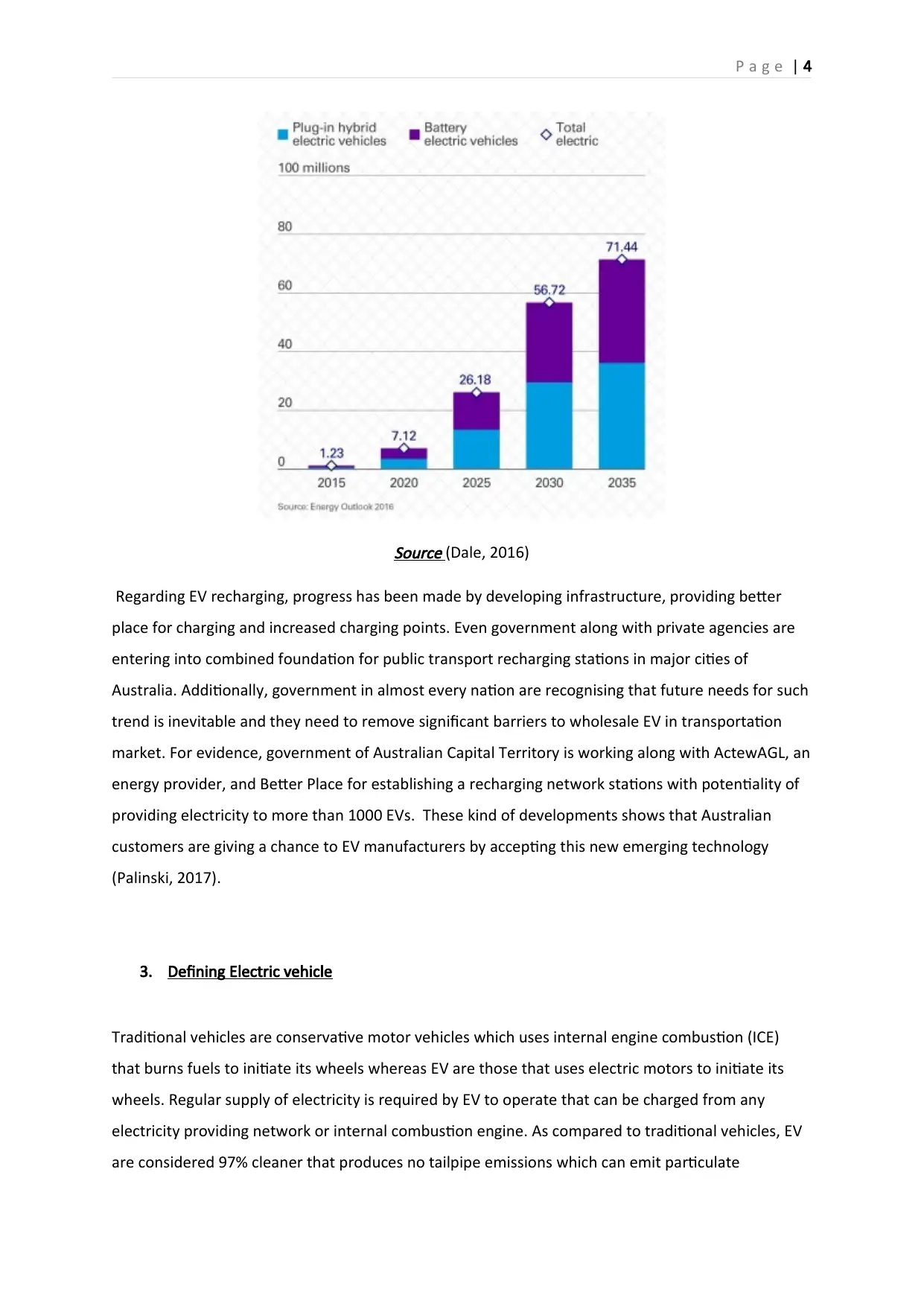
P a g e | 4
Source (Dale, 2016)
Regarding EV recharging, progress has been made by developing infrastructure, providing better
place for charging and increased charging points. Even government along with private agencies are
entering into combined foundation for public transport recharging stations in major cities of
Australia. Additionally, government in almost every nation are recognising that future needs for such
trend is inevitable and they need to remove significant barriers to wholesale EV in transportation
market. For evidence, government of Australian Capital Territory is working along with ActewAGL, an
energy provider, and Better Place for establishing a recharging network stations with potentiality of
providing electricity to more than 1000 EVs. These kind of developments shows that Australian
customers are giving a chance to EV manufacturers by accepting this new emerging technology
(Palinski, 2017).
3. Defining Electric vehicle
Traditional vehicles are conservative motor vehicles which uses internal engine combustion (ICE)
that burns fuels to initiate its wheels whereas EV are those that uses electric motors to initiate its
wheels. Regular supply of electricity is required by EV to operate that can be charged from any
electricity providing network or internal combustion engine. As compared to traditional vehicles, EV
are considered 97% cleaner that produces no tailpipe emissions which can emit particulate
Source (Dale, 2016)
Regarding EV recharging, progress has been made by developing infrastructure, providing better
place for charging and increased charging points. Even government along with private agencies are
entering into combined foundation for public transport recharging stations in major cities of
Australia. Additionally, government in almost every nation are recognising that future needs for such
trend is inevitable and they need to remove significant barriers to wholesale EV in transportation
market. For evidence, government of Australian Capital Territory is working along with ActewAGL, an
energy provider, and Better Place for establishing a recharging network stations with potentiality of
providing electricity to more than 1000 EVs. These kind of developments shows that Australian
customers are giving a chance to EV manufacturers by accepting this new emerging technology
(Palinski, 2017).
3. Defining Electric vehicle
Traditional vehicles are conservative motor vehicles which uses internal engine combustion (ICE)
that burns fuels to initiate its wheels whereas EV are those that uses electric motors to initiate its
wheels. Regular supply of electricity is required by EV to operate that can be charged from any
electricity providing network or internal combustion engine. As compared to traditional vehicles, EV
are considered 97% cleaner that produces no tailpipe emissions which can emit particulate
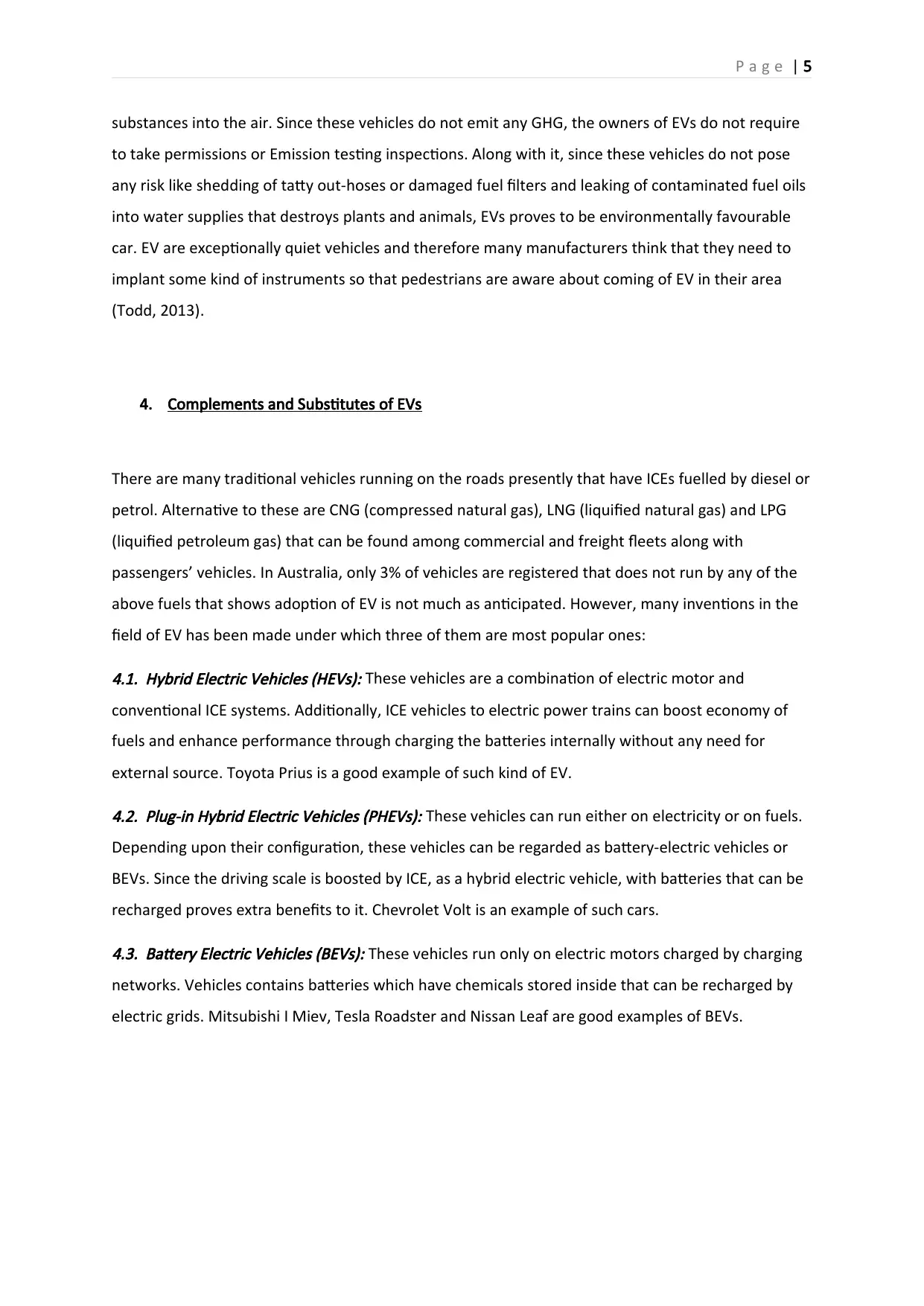
P a g e | 5
substances into the air. Since these vehicles do not emit any GHG, the owners of EVs do not require
to take permissions or Emission testing inspections. Along with it, since these vehicles do not pose
any risk like shedding of tatty out-hoses or damaged fuel filters and leaking of contaminated fuel oils
into water supplies that destroys plants and animals, EVs proves to be environmentally favourable
car. EV are exceptionally quiet vehicles and therefore many manufacturers think that they need to
implant some kind of instruments so that pedestrians are aware about coming of EV in their area
(Todd, 2013).
4. Complements and Substitutes of EVs
There are many traditional vehicles running on the roads presently that have ICEs fuelled by diesel or
petrol. Alternative to these are CNG (compressed natural gas), LNG (liquified natural gas) and LPG
(liquified petroleum gas) that can be found among commercial and freight fleets along with
passengers’ vehicles. In Australia, only 3% of vehicles are registered that does not run by any of the
above fuels that shows adoption of EV is not much as anticipated. However, many inventions in the
field of EV has been made under which three of them are most popular ones:
4.1. Hybrid Electric Vehicles (HEVs): These vehicles are a combination of electric motor and
conventional ICE systems. Additionally, ICE vehicles to electric power trains can boost economy of
fuels and enhance performance through charging the batteries internally without any need for
external source. Toyota Prius is a good example of such kind of EV.
4.2. Plug-in Hybrid Electric Vehicles (PHEVs): These vehicles can run either on electricity or on fuels.
Depending upon their configuration, these vehicles can be regarded as battery-electric vehicles or
BEVs. Since the driving scale is boosted by ICE, as a hybrid electric vehicle, with batteries that can be
recharged proves extra benefits to it. Chevrolet Volt is an example of such cars.
4.3. Battery Electric Vehicles (BEVs): These vehicles run only on electric motors charged by charging
networks. Vehicles contains batteries which have chemicals stored inside that can be recharged by
electric grids. Mitsubishi I Miev, Tesla Roadster and Nissan Leaf are good examples of BEVs.
substances into the air. Since these vehicles do not emit any GHG, the owners of EVs do not require
to take permissions or Emission testing inspections. Along with it, since these vehicles do not pose
any risk like shedding of tatty out-hoses or damaged fuel filters and leaking of contaminated fuel oils
into water supplies that destroys plants and animals, EVs proves to be environmentally favourable
car. EV are exceptionally quiet vehicles and therefore many manufacturers think that they need to
implant some kind of instruments so that pedestrians are aware about coming of EV in their area
(Todd, 2013).
4. Complements and Substitutes of EVs
There are many traditional vehicles running on the roads presently that have ICEs fuelled by diesel or
petrol. Alternative to these are CNG (compressed natural gas), LNG (liquified natural gas) and LPG
(liquified petroleum gas) that can be found among commercial and freight fleets along with
passengers’ vehicles. In Australia, only 3% of vehicles are registered that does not run by any of the
above fuels that shows adoption of EV is not much as anticipated. However, many inventions in the
field of EV has been made under which three of them are most popular ones:
4.1. Hybrid Electric Vehicles (HEVs): These vehicles are a combination of electric motor and
conventional ICE systems. Additionally, ICE vehicles to electric power trains can boost economy of
fuels and enhance performance through charging the batteries internally without any need for
external source. Toyota Prius is a good example of such kind of EV.
4.2. Plug-in Hybrid Electric Vehicles (PHEVs): These vehicles can run either on electricity or on fuels.
Depending upon their configuration, these vehicles can be regarded as battery-electric vehicles or
BEVs. Since the driving scale is boosted by ICE, as a hybrid electric vehicle, with batteries that can be
recharged proves extra benefits to it. Chevrolet Volt is an example of such cars.
4.3. Battery Electric Vehicles (BEVs): These vehicles run only on electric motors charged by charging
networks. Vehicles contains batteries which have chemicals stored inside that can be recharged by
electric grids. Mitsubishi I Miev, Tesla Roadster and Nissan Leaf are good examples of BEVs.
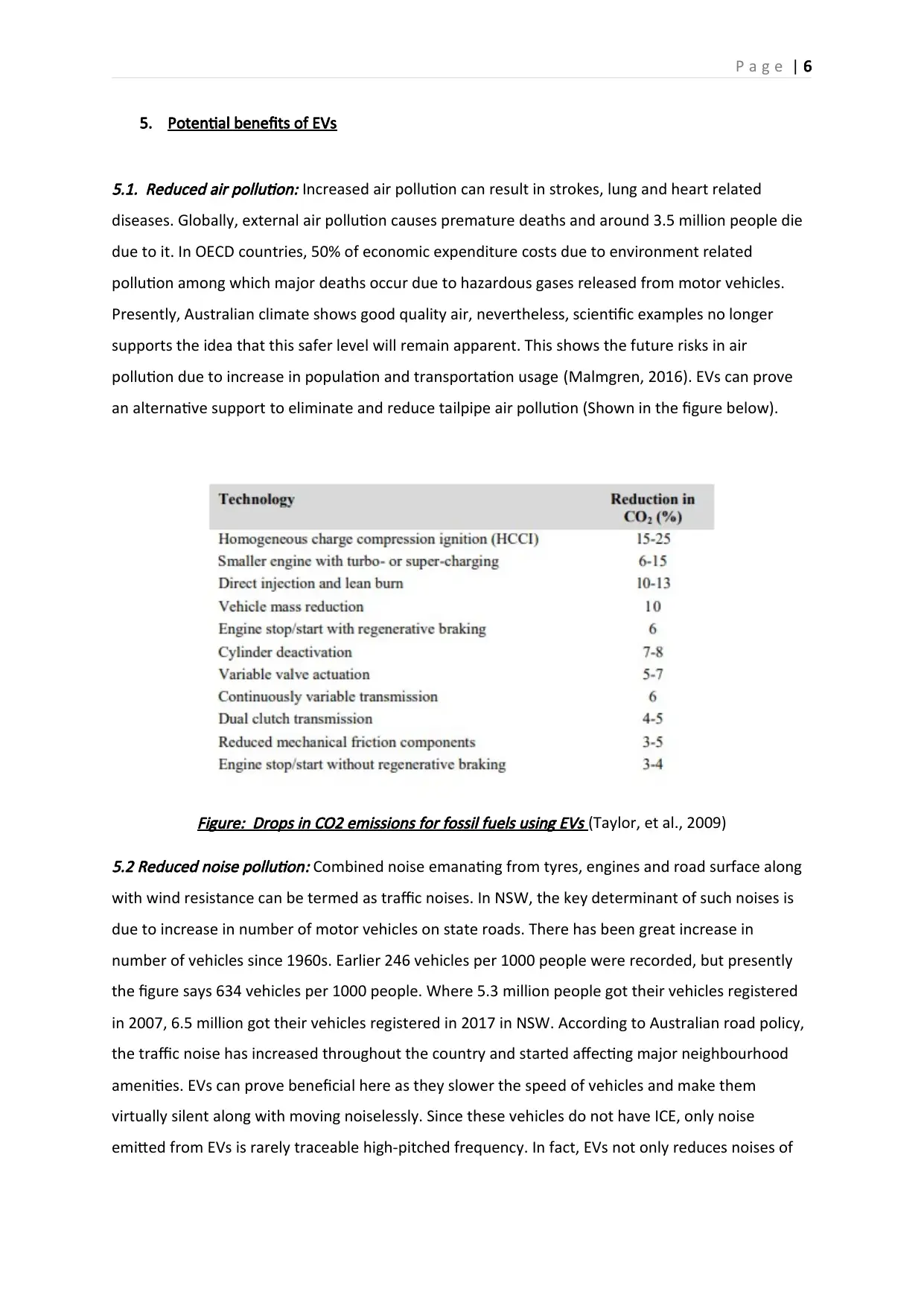
P a g e | 6
5. Potential benefits of EVs
5.1. Reduced air pollution: Increased air pollution can result in strokes, lung and heart related
diseases. Globally, external air pollution causes premature deaths and around 3.5 million people die
due to it. In OECD countries, 50% of economic expenditure costs due to environment related
pollution among which major deaths occur due to hazardous gases released from motor vehicles.
Presently, Australian climate shows good quality air, nevertheless, scientific examples no longer
supports the idea that this safer level will remain apparent. This shows the future risks in air
pollution due to increase in population and transportation usage (Malmgren, 2016). EVs can prove
an alternative support to eliminate and reduce tailpipe air pollution (Shown in the figure below).
Figure: Drops in CO2 emissions for fossil fuels using EVs (Taylor, et al., 2009)
5.2 Reduced noise pollution: Combined noise emanating from tyres, engines and road surface along
with wind resistance can be termed as traffic noises. In NSW, the key determinant of such noises is
due to increase in number of motor vehicles on state roads. There has been great increase in
number of vehicles since 1960s. Earlier 246 vehicles per 1000 people were recorded, but presently
the figure says 634 vehicles per 1000 people. Where 5.3 million people got their vehicles registered
in 2007, 6.5 million got their vehicles registered in 2017 in NSW. According to Australian road policy,
the traffic noise has increased throughout the country and started affecting major neighbourhood
amenities. EVs can prove beneficial here as they slower the speed of vehicles and make them
virtually silent along with moving noiselessly. Since these vehicles do not have ICE, only noise
emitted from EVs is rarely traceable high-pitched frequency. In fact, EVs not only reduces noises of
5. Potential benefits of EVs
5.1. Reduced air pollution: Increased air pollution can result in strokes, lung and heart related
diseases. Globally, external air pollution causes premature deaths and around 3.5 million people die
due to it. In OECD countries, 50% of economic expenditure costs due to environment related
pollution among which major deaths occur due to hazardous gases released from motor vehicles.
Presently, Australian climate shows good quality air, nevertheless, scientific examples no longer
supports the idea that this safer level will remain apparent. This shows the future risks in air
pollution due to increase in population and transportation usage (Malmgren, 2016). EVs can prove
an alternative support to eliminate and reduce tailpipe air pollution (Shown in the figure below).
Figure: Drops in CO2 emissions for fossil fuels using EVs (Taylor, et al., 2009)
5.2 Reduced noise pollution: Combined noise emanating from tyres, engines and road surface along
with wind resistance can be termed as traffic noises. In NSW, the key determinant of such noises is
due to increase in number of motor vehicles on state roads. There has been great increase in
number of vehicles since 1960s. Earlier 246 vehicles per 1000 people were recorded, but presently
the figure says 634 vehicles per 1000 people. Where 5.3 million people got their vehicles registered
in 2007, 6.5 million got their vehicles registered in 2017 in NSW. According to Australian road policy,
the traffic noise has increased throughout the country and started affecting major neighbourhood
amenities. EVs can prove beneficial here as they slower the speed of vehicles and make them
virtually silent along with moving noiselessly. Since these vehicles do not have ICE, only noise
emitted from EVs is rarely traceable high-pitched frequency. In fact, EVs not only reduces noises of
Paraphrase This Document
Need a fresh take? Get an instant paraphrase of this document with our AI Paraphraser
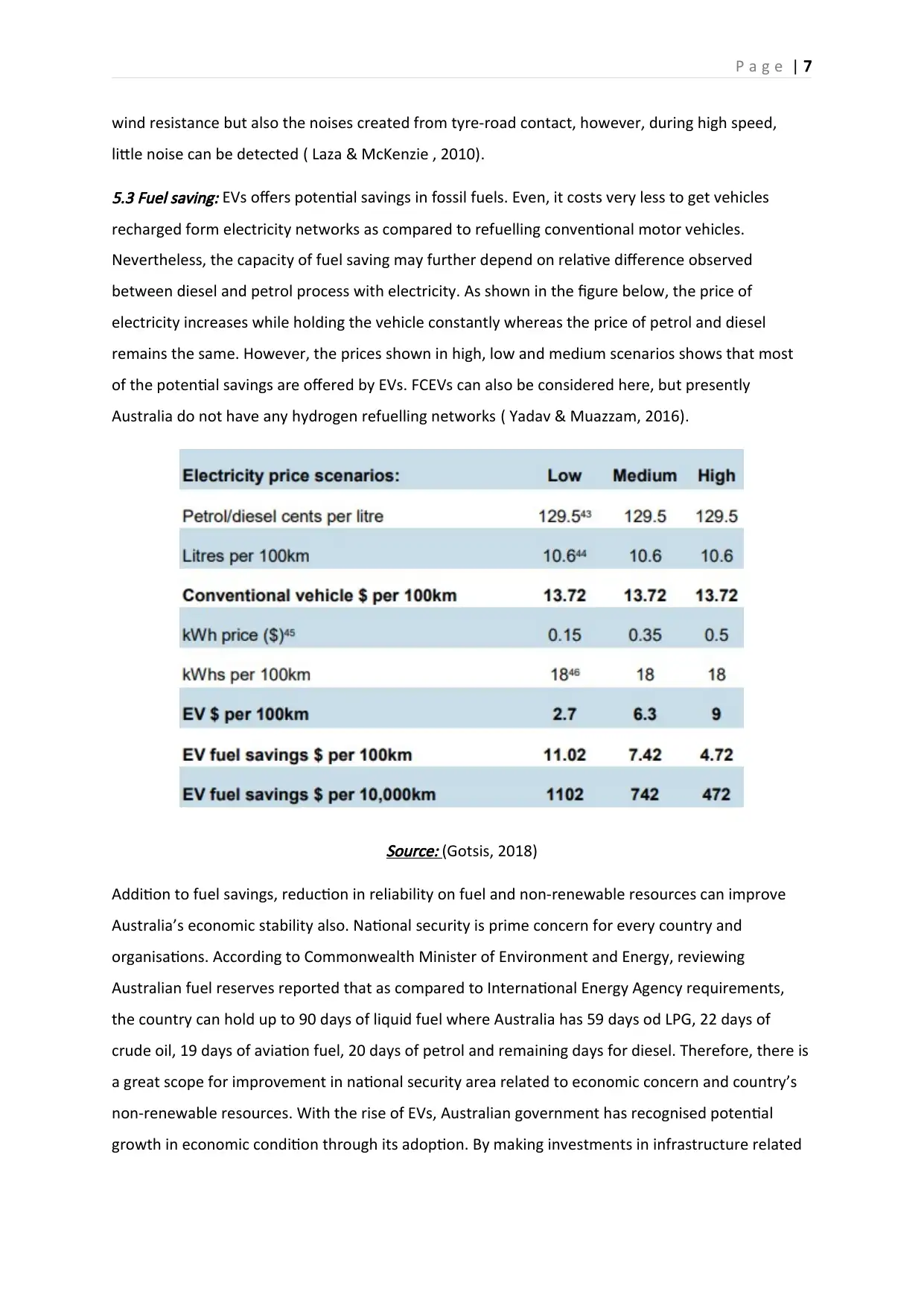
P a g e | 7
wind resistance but also the noises created from tyre-road contact, however, during high speed,
little noise can be detected ( Laza & McKenzie , 2010).
5.3 Fuel saving: EVs offers potential savings in fossil fuels. Even, it costs very less to get vehicles
recharged form electricity networks as compared to refuelling conventional motor vehicles.
Nevertheless, the capacity of fuel saving may further depend on relative difference observed
between diesel and petrol process with electricity. As shown in the figure below, the price of
electricity increases while holding the vehicle constantly whereas the price of petrol and diesel
remains the same. However, the prices shown in high, low and medium scenarios shows that most
of the potential savings are offered by EVs. FCEVs can also be considered here, but presently
Australia do not have any hydrogen refuelling networks ( Yadav & Muazzam, 2016).
Source: (Gotsis, 2018)
Addition to fuel savings, reduction in reliability on fuel and non-renewable resources can improve
Australia’s economic stability also. National security is prime concern for every country and
organisations. According to Commonwealth Minister of Environment and Energy, reviewing
Australian fuel reserves reported that as compared to International Energy Agency requirements,
the country can hold up to 90 days of liquid fuel where Australia has 59 days od LPG, 22 days of
crude oil, 19 days of aviation fuel, 20 days of petrol and remaining days for diesel. Therefore, there is
a great scope for improvement in national security area related to economic concern and country’s
non-renewable resources. With the rise of EVs, Australian government has recognised potential
growth in economic condition through its adoption. By making investments in infrastructure related
wind resistance but also the noises created from tyre-road contact, however, during high speed,
little noise can be detected ( Laza & McKenzie , 2010).
5.3 Fuel saving: EVs offers potential savings in fossil fuels. Even, it costs very less to get vehicles
recharged form electricity networks as compared to refuelling conventional motor vehicles.
Nevertheless, the capacity of fuel saving may further depend on relative difference observed
between diesel and petrol process with electricity. As shown in the figure below, the price of
electricity increases while holding the vehicle constantly whereas the price of petrol and diesel
remains the same. However, the prices shown in high, low and medium scenarios shows that most
of the potential savings are offered by EVs. FCEVs can also be considered here, but presently
Australia do not have any hydrogen refuelling networks ( Yadav & Muazzam, 2016).
Source: (Gotsis, 2018)
Addition to fuel savings, reduction in reliability on fuel and non-renewable resources can improve
Australia’s economic stability also. National security is prime concern for every country and
organisations. According to Commonwealth Minister of Environment and Energy, reviewing
Australian fuel reserves reported that as compared to International Energy Agency requirements,
the country can hold up to 90 days of liquid fuel where Australia has 59 days od LPG, 22 days of
crude oil, 19 days of aviation fuel, 20 days of petrol and remaining days for diesel. Therefore, there is
a great scope for improvement in national security area related to economic concern and country’s
non-renewable resources. With the rise of EVs, Australian government has recognised potential
growth in economic condition through its adoption. By making investments in infrastructure related
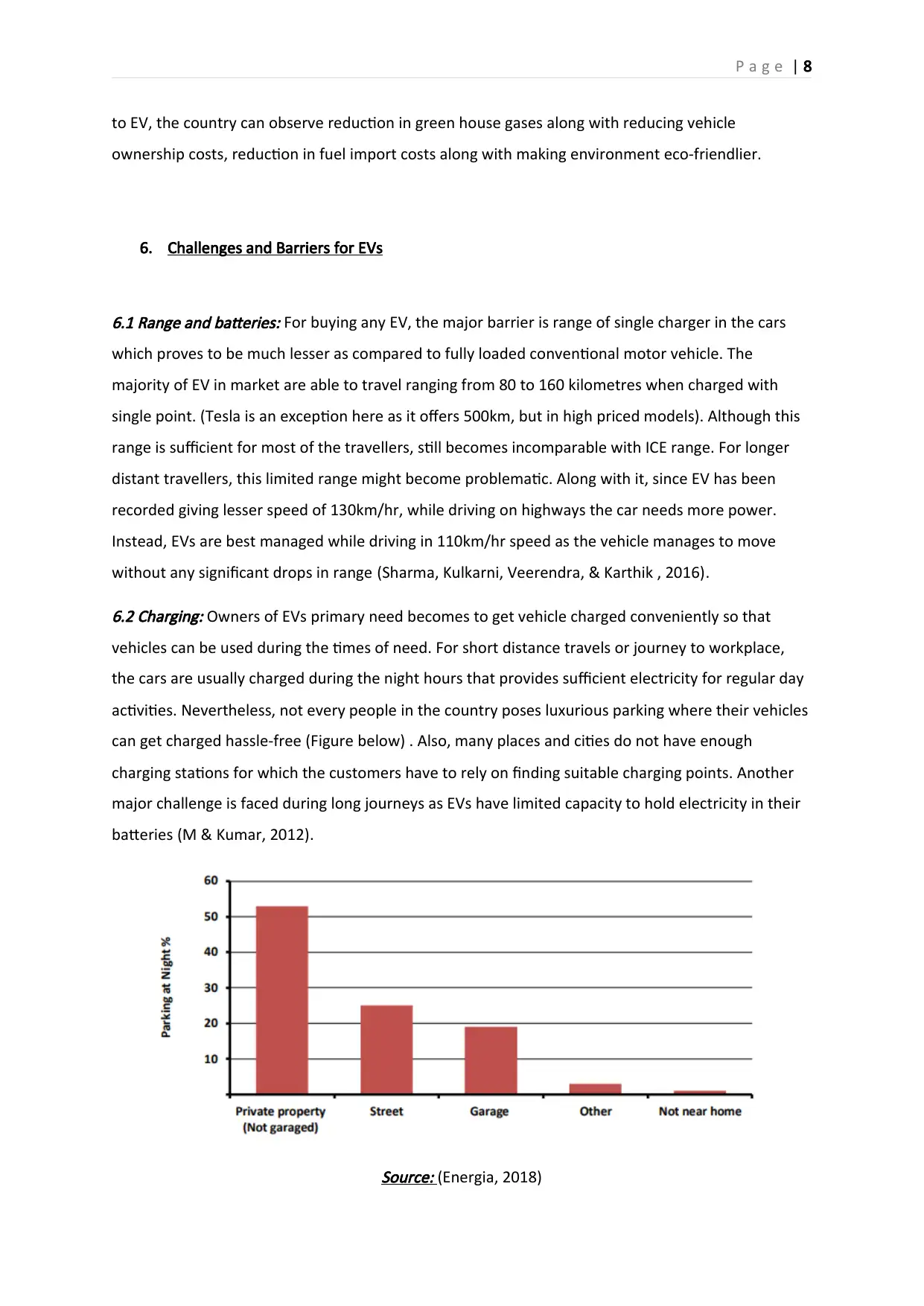
P a g e | 8
to EV, the country can observe reduction in green house gases along with reducing vehicle
ownership costs, reduction in fuel import costs along with making environment eco-friendlier.
6. Challenges and Barriers for EVs
6.1 Range and batteries: For buying any EV, the major barrier is range of single charger in the cars
which proves to be much lesser as compared to fully loaded conventional motor vehicle. The
majority of EV in market are able to travel ranging from 80 to 160 kilometres when charged with
single point. (Tesla is an exception here as it offers 500km, but in high priced models). Although this
range is sufficient for most of the travellers, still becomes incomparable with ICE range. For longer
distant travellers, this limited range might become problematic. Along with it, since EV has been
recorded giving lesser speed of 130km/hr, while driving on highways the car needs more power.
Instead, EVs are best managed while driving in 110km/hr speed as the vehicle manages to move
without any significant drops in range (Sharma, Kulkarni, Veerendra, & Karthik , 2016).
6.2 Charging: Owners of EVs primary need becomes to get vehicle charged conveniently so that
vehicles can be used during the times of need. For short distance travels or journey to workplace,
the cars are usually charged during the night hours that provides sufficient electricity for regular day
activities. Nevertheless, not every people in the country poses luxurious parking where their vehicles
can get charged hassle-free (Figure below) . Also, many places and cities do not have enough
charging stations for which the customers have to rely on finding suitable charging points. Another
major challenge is faced during long journeys as EVs have limited capacity to hold electricity in their
batteries (M & Kumar, 2012).
Source: (Energia, 2018)
to EV, the country can observe reduction in green house gases along with reducing vehicle
ownership costs, reduction in fuel import costs along with making environment eco-friendlier.
6. Challenges and Barriers for EVs
6.1 Range and batteries: For buying any EV, the major barrier is range of single charger in the cars
which proves to be much lesser as compared to fully loaded conventional motor vehicle. The
majority of EV in market are able to travel ranging from 80 to 160 kilometres when charged with
single point. (Tesla is an exception here as it offers 500km, but in high priced models). Although this
range is sufficient for most of the travellers, still becomes incomparable with ICE range. For longer
distant travellers, this limited range might become problematic. Along with it, since EV has been
recorded giving lesser speed of 130km/hr, while driving on highways the car needs more power.
Instead, EVs are best managed while driving in 110km/hr speed as the vehicle manages to move
without any significant drops in range (Sharma, Kulkarni, Veerendra, & Karthik , 2016).
6.2 Charging: Owners of EVs primary need becomes to get vehicle charged conveniently so that
vehicles can be used during the times of need. For short distance travels or journey to workplace,
the cars are usually charged during the night hours that provides sufficient electricity for regular day
activities. Nevertheless, not every people in the country poses luxurious parking where their vehicles
can get charged hassle-free (Figure below) . Also, many places and cities do not have enough
charging stations for which the customers have to rely on finding suitable charging points. Another
major challenge is faced during long journeys as EVs have limited capacity to hold electricity in their
batteries (M & Kumar, 2012).
Source: (Energia, 2018)
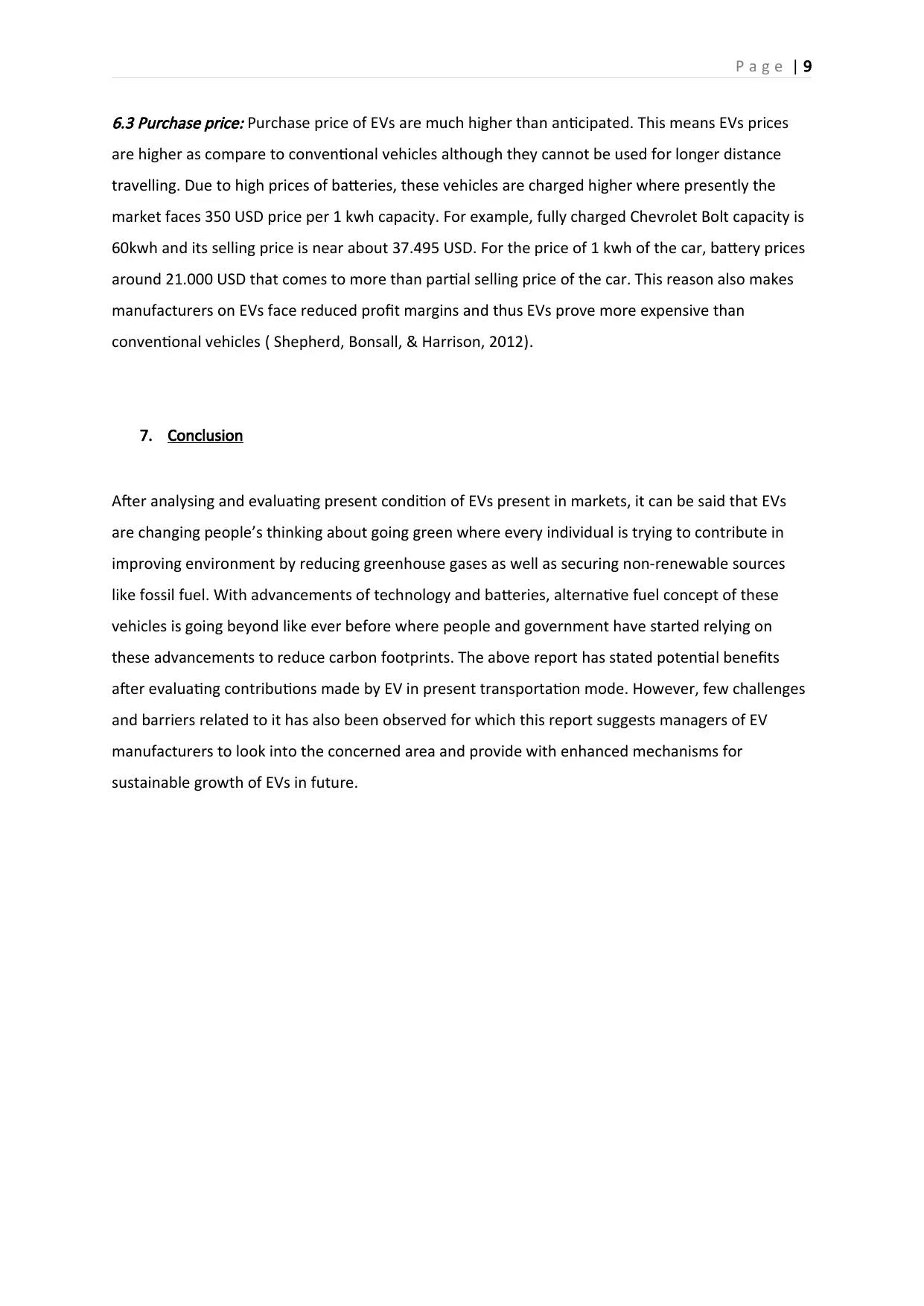
P a g e | 9
6.3 Purchase price: Purchase price of EVs are much higher than anticipated. This means EVs prices
are higher as compare to conventional vehicles although they cannot be used for longer distance
travelling. Due to high prices of batteries, these vehicles are charged higher where presently the
market faces 350 USD price per 1 kwh capacity. For example, fully charged Chevrolet Bolt capacity is
60kwh and its selling price is near about 37.495 USD. For the price of 1 kwh of the car, battery prices
around 21.000 USD that comes to more than partial selling price of the car. This reason also makes
manufacturers on EVs face reduced profit margins and thus EVs prove more expensive than
conventional vehicles ( Shepherd, Bonsall, & Harrison, 2012).
7. Conclusion
After analysing and evaluating present condition of EVs present in markets, it can be said that EVs
are changing people’s thinking about going green where every individual is trying to contribute in
improving environment by reducing greenhouse gases as well as securing non-renewable sources
like fossil fuel. With advancements of technology and batteries, alternative fuel concept of these
vehicles is going beyond like ever before where people and government have started relying on
these advancements to reduce carbon footprints. The above report has stated potential benefits
after evaluating contributions made by EV in present transportation mode. However, few challenges
and barriers related to it has also been observed for which this report suggests managers of EV
manufacturers to look into the concerned area and provide with enhanced mechanisms for
sustainable growth of EVs in future.
6.3 Purchase price: Purchase price of EVs are much higher than anticipated. This means EVs prices
are higher as compare to conventional vehicles although they cannot be used for longer distance
travelling. Due to high prices of batteries, these vehicles are charged higher where presently the
market faces 350 USD price per 1 kwh capacity. For example, fully charged Chevrolet Bolt capacity is
60kwh and its selling price is near about 37.495 USD. For the price of 1 kwh of the car, battery prices
around 21.000 USD that comes to more than partial selling price of the car. This reason also makes
manufacturers on EVs face reduced profit margins and thus EVs prove more expensive than
conventional vehicles ( Shepherd, Bonsall, & Harrison, 2012).
7. Conclusion
After analysing and evaluating present condition of EVs present in markets, it can be said that EVs
are changing people’s thinking about going green where every individual is trying to contribute in
improving environment by reducing greenhouse gases as well as securing non-renewable sources
like fossil fuel. With advancements of technology and batteries, alternative fuel concept of these
vehicles is going beyond like ever before where people and government have started relying on
these advancements to reduce carbon footprints. The above report has stated potential benefits
after evaluating contributions made by EV in present transportation mode. However, few challenges
and barriers related to it has also been observed for which this report suggests managers of EV
manufacturers to look into the concerned area and provide with enhanced mechanisms for
sustainable growth of EVs in future.
Secure Best Marks with AI Grader
Need help grading? Try our AI Grader for instant feedback on your assignments.
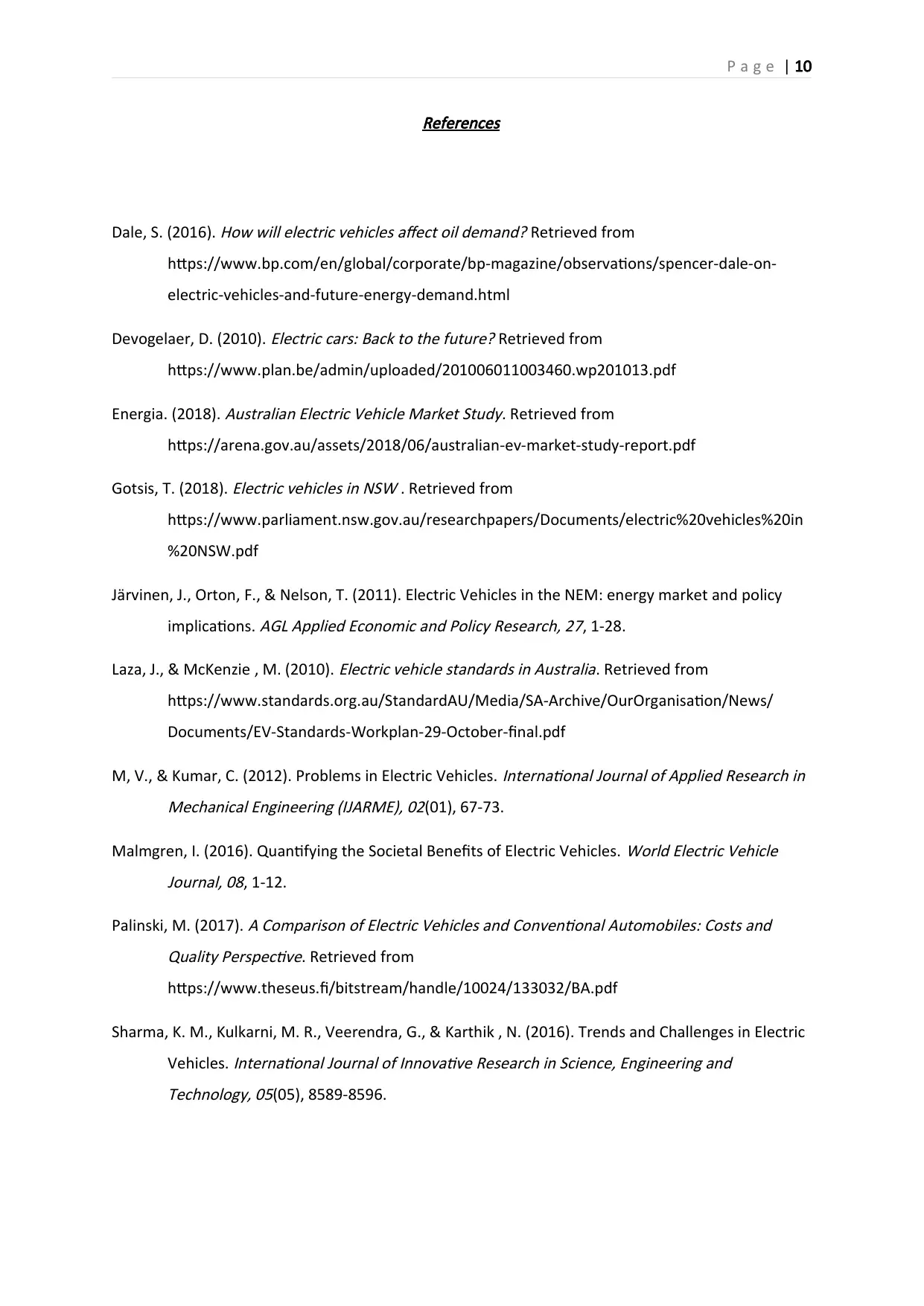
P a g e | 10
References
Dale, S. (2016).
How will electric vehicles affect oil demand? Retrieved from
https://www.bp.com/en/global/corporate/bp-magazine/observations/spencer-dale-on-
electric-vehicles-and-future-energy-demand.html
Devogelaer, D. (2010).
Electric cars: Back to the future? Retrieved from
https://www.plan.be/admin/uploaded/201006011003460.wp201013.pdf
Energia. (2018).
Australian Electric Vehicle Market Study. Retrieved from
https://arena.gov.au/assets/2018/06/australian-ev-market-study-report.pdf
Gotsis, T. (2018).
Electric vehicles in NSW . Retrieved from
https://www.parliament.nsw.gov.au/researchpapers/Documents/electric%20vehicles%20in
%20NSW.pdf
Järvinen, J., Orton, F., & Nelson, T. (2011). Electric Vehicles in the NEM: energy market and policy
implications.
AGL Applied Economic and Policy Research, 27, 1-28.
Laza, J., & McKenzie , M. (2010).
Electric vehicle standards in Australia. Retrieved from
https://www.standards.org.au/StandardAU/Media/SA-Archive/OurOrganisation/News/
Documents/EV-Standards-Workplan-29-October-final.pdf
M, V., & Kumar, C. (2012). Problems in Electric Vehicles.
International Journal of Applied Research in
Mechanical Engineering (IJARME), 02(01), 67-73.
Malmgren, I. (2016). Quantifying the Societal Benefits of Electric Vehicles.
World Electric Vehicle
Journal, 08, 1-12.
Palinski, M. (2017).
A Comparison of Electric Vehicles and Conventional Automobiles: Costs and
Quality Perspective. Retrieved from
https://www.theseus.fi/bitstream/handle/10024/133032/BA.pdf
Sharma, K. M., Kulkarni, M. R., Veerendra, G., & Karthik , N. (2016). Trends and Challenges in Electric
Vehicles.
International Journal of Innovative Research in Science, Engineering and
Technology, 05(05), 8589-8596.
References
Dale, S. (2016).
How will electric vehicles affect oil demand? Retrieved from
https://www.bp.com/en/global/corporate/bp-magazine/observations/spencer-dale-on-
electric-vehicles-and-future-energy-demand.html
Devogelaer, D. (2010).
Electric cars: Back to the future? Retrieved from
https://www.plan.be/admin/uploaded/201006011003460.wp201013.pdf
Energia. (2018).
Australian Electric Vehicle Market Study. Retrieved from
https://arena.gov.au/assets/2018/06/australian-ev-market-study-report.pdf
Gotsis, T. (2018).
Electric vehicles in NSW . Retrieved from
https://www.parliament.nsw.gov.au/researchpapers/Documents/electric%20vehicles%20in
%20NSW.pdf
Järvinen, J., Orton, F., & Nelson, T. (2011). Electric Vehicles in the NEM: energy market and policy
implications.
AGL Applied Economic and Policy Research, 27, 1-28.
Laza, J., & McKenzie , M. (2010).
Electric vehicle standards in Australia. Retrieved from
https://www.standards.org.au/StandardAU/Media/SA-Archive/OurOrganisation/News/
Documents/EV-Standards-Workplan-29-October-final.pdf
M, V., & Kumar, C. (2012). Problems in Electric Vehicles.
International Journal of Applied Research in
Mechanical Engineering (IJARME), 02(01), 67-73.
Malmgren, I. (2016). Quantifying the Societal Benefits of Electric Vehicles.
World Electric Vehicle
Journal, 08, 1-12.
Palinski, M. (2017).
A Comparison of Electric Vehicles and Conventional Automobiles: Costs and
Quality Perspective. Retrieved from
https://www.theseus.fi/bitstream/handle/10024/133032/BA.pdf
Sharma, K. M., Kulkarni, M. R., Veerendra, G., & Karthik , N. (2016). Trends and Challenges in Electric
Vehicles.
International Journal of Innovative Research in Science, Engineering and
Technology, 05(05), 8589-8596.
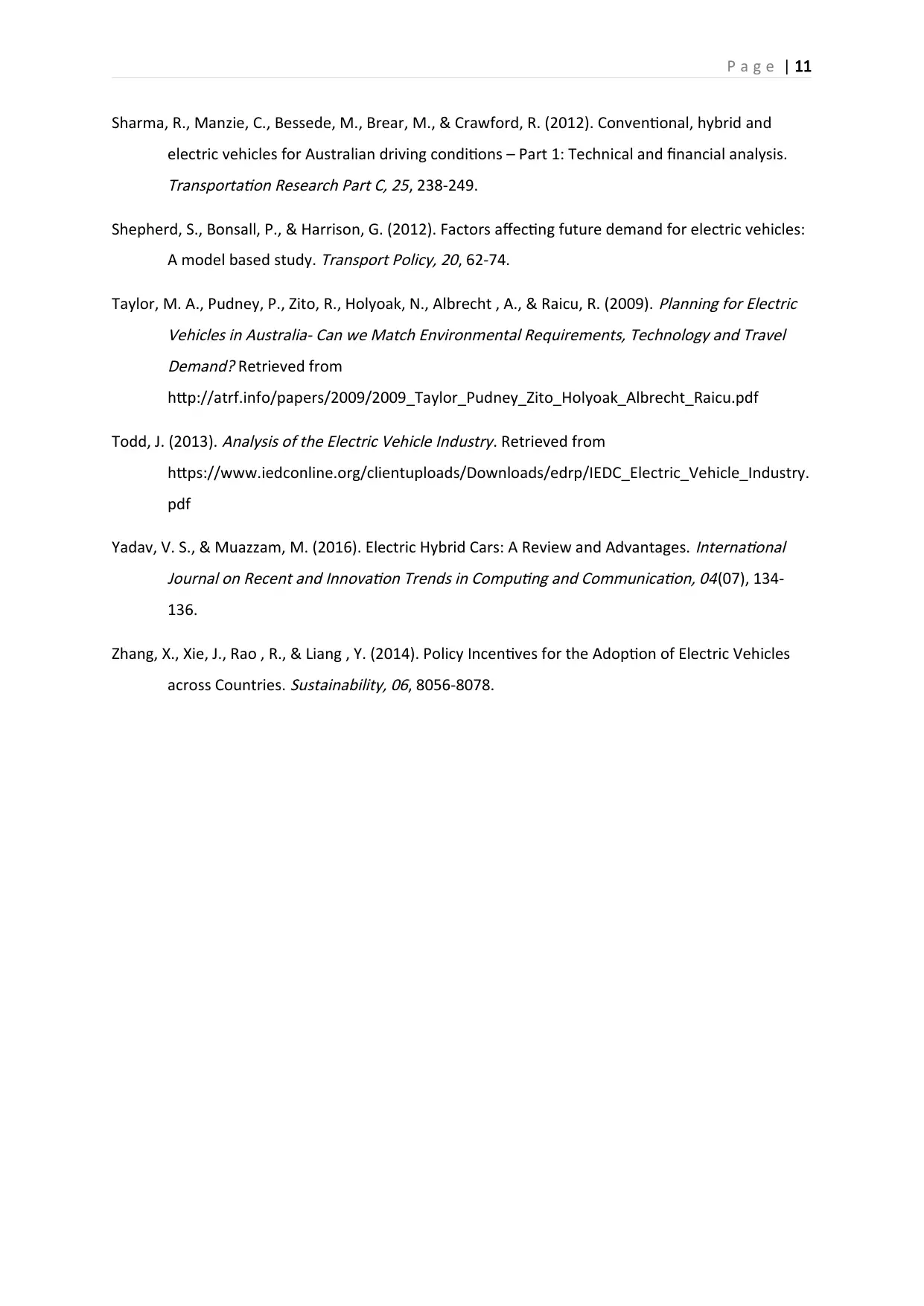
P a g e | 11
Sharma, R., Manzie, C., Bessede, M., Brear, M., & Crawford, R. (2012). Conventional, hybrid and
electric vehicles for Australian driving conditions – Part 1: Technical and financial analysis.
Transportation Research Part C, 25, 238-249.
Shepherd, S., Bonsall, P., & Harrison, G. (2012). Factors affecting future demand for electric vehicles:
A model based study.
Transport Policy, 20, 62-74.
Taylor, M. A., Pudney, P., Zito, R., Holyoak, N., Albrecht , A., & Raicu, R. (2009).
Planning for Electric
Vehicles in Australia- Can we Match Environmental Requirements, Technology and Travel
Demand? Retrieved from
http://atrf.info/papers/2009/2009_Taylor_Pudney_Zito_Holyoak_Albrecht_Raicu.pdf
Todd, J. (2013).
Analysis of the Electric Vehicle Industry. Retrieved from
https://www.iedconline.org/clientuploads/Downloads/edrp/IEDC_Electric_Vehicle_Industry.
pdf
Yadav, V. S., & Muazzam, M. (2016). Electric Hybrid Cars: A Review and Advantages.
International
Journal on Recent and Innovation Trends in Computing and Communication, 04(07), 134-
136.
Zhang, X., Xie, J., Rao , R., & Liang , Y. (2014). Policy Incentives for the Adoption of Electric Vehicles
across Countries.
Sustainability, 06, 8056-8078.
Sharma, R., Manzie, C., Bessede, M., Brear, M., & Crawford, R. (2012). Conventional, hybrid and
electric vehicles for Australian driving conditions – Part 1: Technical and financial analysis.
Transportation Research Part C, 25, 238-249.
Shepherd, S., Bonsall, P., & Harrison, G. (2012). Factors affecting future demand for electric vehicles:
A model based study.
Transport Policy, 20, 62-74.
Taylor, M. A., Pudney, P., Zito, R., Holyoak, N., Albrecht , A., & Raicu, R. (2009).
Planning for Electric
Vehicles in Australia- Can we Match Environmental Requirements, Technology and Travel
Demand? Retrieved from
http://atrf.info/papers/2009/2009_Taylor_Pudney_Zito_Holyoak_Albrecht_Raicu.pdf
Todd, J. (2013).
Analysis of the Electric Vehicle Industry. Retrieved from
https://www.iedconline.org/clientuploads/Downloads/edrp/IEDC_Electric_Vehicle_Industry.
Yadav, V. S., & Muazzam, M. (2016). Electric Hybrid Cars: A Review and Advantages.
International
Journal on Recent and Innovation Trends in Computing and Communication, 04(07), 134-
136.
Zhang, X., Xie, J., Rao , R., & Liang , Y. (2014). Policy Incentives for the Adoption of Electric Vehicles
across Countries.
Sustainability, 06, 8056-8078.
1 out of 12
Related Documents
Your All-in-One AI-Powered Toolkit for Academic Success.
+13062052269
info@desklib.com
Available 24*7 on WhatsApp / Email
![[object Object]](/_next/static/media/star-bottom.7253800d.svg)
Unlock your academic potential
© 2024 | Zucol Services PVT LTD | All rights reserved.





